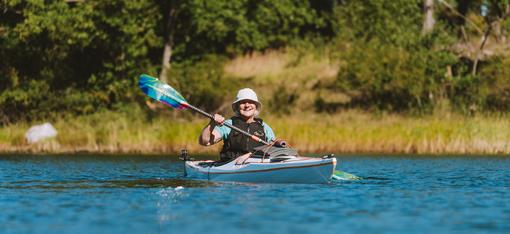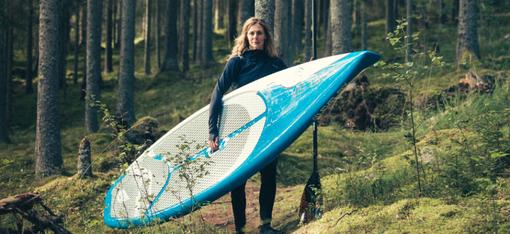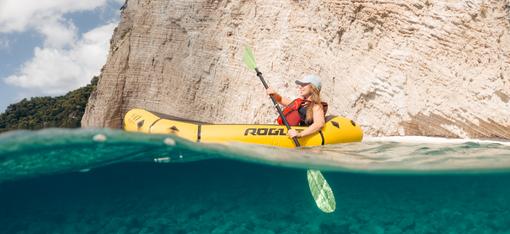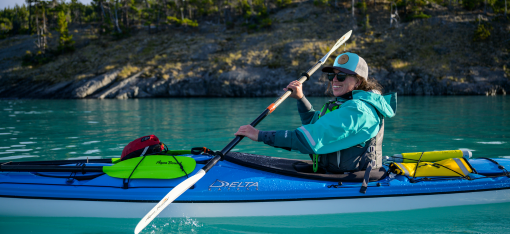Packrafting Kakariki: New Zealand’s Turquoise Canyon
6-minute read
Deane Parker, New Zealand adventurer and filmmaker, just released his new film Kakariki: The Turquoise Canyon. Here, he shares the backstory of his group’s packrafting journey down this steep, technical river on New Zealand’s West Coast.

Kakariki: The Turquoise Canyon Backstory
By Deane Parker
The sheer-walled canyons of the West Coast have always been close to my heart since I discovered them in the early nineties. That led me to guiding my own trips through the Hokitika and Arahura rivers in the 2000s.
These canyons have been carved through this quite soft and new geologically schist gorges, leaving stunning whitewater, mostly very challenging. Few have access outside of unmaintained bush tracks.

Jimmy and Jared
For almost two decades, they drew the attention of the whitewater kayaking elite of the world. Substantial numbers travelled to New Zealand and bee-lined it to the little seaside town of Hokitika. They camped at the Department of Conservation’s Lake Mahinapua Campground and used a handful of helicopter operators with fistfuls of cash to fly into the almost dozen most classic runs.
In those days, aviation fuel was cheap, and the multitude of ex-deer-culling helicopters were easily accessible. So it was possible to get a heli lift in for $60-80 NZD per person.
Especially since NZ stopped refining fuel, the heli prices are much more restrictive for the average dirtbag boater (quote Jule Harle). The numbers dwindled, and now most rivers only see a few parties a year, if that.
More recently, some of the lower runs and a select few longer trips have gained popularity with packrafters, especially the Karamea and Landsborough. The rivers are steep in the headwaters and ease out as they exit the mountains.
For a few years, the boundaries have been pushed in a few catchments by the limitations of packrafts' ability to run challenging whitewater.
I had been thinking of the Hokitika River’s Kakariki Canyon—several kilometres upstream of the iconic tourist attraction of the Hokitika Gorge—for some time.
When Thor from Alpacka Raft let me into the development of the new Mage platform, it seemed fitting to plan a project to put this new boat, built for Class 3-4, through its paces in one of the most stunning places of river running in New Zealand.

Tina dropping in
I had been paddling a self-bailing Gnarwhal since 2018, and had gotten completely comfortable with the hull and overall boat for my bikerafting expeditions and also for hiking into the Class 3-4 low-volume rivers of Golden Bay and the West Coast.
There were limitations, though. The short overall length and stubby bow weren’t ideal for punching through hydraulics, fast ferries and quick turns.
The early photos I saw of the Mage offered improvements in these areas. The design further piqued my interest with the Venturi self-bailing system, with this being my preferred option to allow easy access for filming and less faff. I was pleased to receive two Mages in time for the expedition.
I had connected with Jule Harle from the Alaska Packrafting School to join a team of six to paddle and capture the hike and descent. Other team members were Jimmy and Jared from the Following Footsteps of River Runners project, and Tina Grove, a doctor from Christchurch, who is up and coming in the Canterbury packrafting community. My old mate Dylan Gerschwitz would support with his amazing camera skills from shore.

Jimmy enters a boulder garden
We chose to walk the first day up the river to the Rapid Creek Hut for the night to give us a whole day to run the canyon back to the hut.
The walk is an unremarkable 3-hour jaunt until a kilometre before the hut, where there is one of the last remaining cableways on the West Coast. It’s quite a wild ride as the little one-person box trolley picks up speed towards the low point of the cable and your mates wind you back in.
After a comfortable night, we set off early back across the cableway and into the depths of the forest, scrambling over some pretty exposed sections above the river.
The river was thundering and obviously much higher than on Jules' scout trip a few weeks back. The sun was out, though, and we agreed that whilst there would be some stout portaging, it was stunning and still looked plenty runnable.

Jule, just below their put in
At the put in, the intense beauty and isolation of the place really struck. The dark green temperate rainforest provides stark contrast to the turquoise or azure blue of the glacial water and the smooth-polished, sparkly grey schist rock.
We set off anxiously through the first Class 3 drops and had two swims early. That kinda rattled the team, but we got in the groove and then progressed down the river nicely. There are two distinct sub-canyons. The first is like something out of heaven. And we took flipping ages because we were shooting and droning as we went.

Deane films from the shore
It’s an amazing run for advanced packrafters in the 20-70 cumec (cubic metre per second) range. The rapids are close together, and in a couple of spots, it was hard to see around the corner. The teamwork required on a river like this is not to be underestimated, with safety being set and the use of effective hand signals to relay information to the others about what was coming up.
It really showed the ability of the new generation curved-hull packrafts to get closer again in performance to kayaks, yet still be packable enough to take into the most remote and isolated rivers on the planet.
The Mage is the most whitewater-capable self-bailing packraft I’ve paddled to date. There’s some familiarisation required to move from the flat-bottomed packrafts to these, but once acclimatised, the speed, punch and maneuverability of the Mage is excellent.
Continually, the technology of the boat, paddle and other specific packrafting equipment is opening doors to push the limit of accessibility. The Aqua Bound Aerial 4-piece Versa-Lok paddle is an example of this.

Jule used our Aeriel Carbon
Before the Aerial was released, I was a happy Whisky user, it being the lightest paddle for extended, bigger-volume whitewater on the planet. The Aerial upped the ante in terms of strength and durability, especially in smaller-volume rocky rivers.
Whilst adding grams to the Whisky, the positive feel of the stiffer blade and grippier carbon shaft has enabled my confidence for running harder whitewater to match the improved performance of the Alpacka Mage.
Hiking into rivers of the West Coast requires considerably more physical effort than the heli shuttles of yesteryear. But the experience transcends the noise, the risk, the cost and the impact. It’s a higher level of fulfillment—the human-powered, low-impact adventure travel that packrafts enable.
* * * * *
Our thanks to Deane for his story! Watch “Kakariki: The Turquoise Canyon” here.
All photos courtesy of Deane Parker.
Learn more about Alpacka Raft's new Mage packraft.
What paddling questions can our friendly Customer Service team help you with? Contact us at 715-755-3405 or sales@aquabound.com, or choose our online chat option.
More for you...





